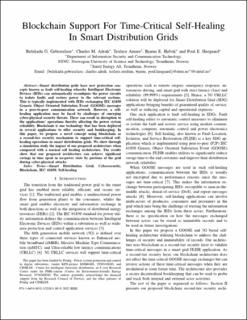Blockchain Support For Time-Critical Self-Healing In Smart Distribution Grids
Gebraselase, Befekadu; Adrah, Charles Mawutor; Zerihun, Tesfaye Amare; Helvik, Bjarne Emil; Heegaard, Poul Einar
Chapter
Accepted version

Permanent lenke
https://hdl.handle.net/11250/3047166Utgivelsesdato
2022Metadata
Vis full innførselSamlinger
Originalversjon
10.1109/ISGT-Europe54678.2022.9960615Sammendrag
Smart distribution grids have new protection concepts known as fault self-healing whereby Intelligent Electronic Devices (IEDs) can automatically reconfigure the power circuits to isolate faults and restore power to the relevant sections. This is typically implemented with IEDs exchanging IEC 61850 Generic Object Oriented Substation Event (GOOSE) messages in a peer-to-peer communication network. However, a self-healing application may be faced by challenges of emerging cyber-physical security threats. These can result in disruption to the applications’ operations thereby affecting the power system reliability. Blockchain is one technology that has been deployed in several applications to offer security and bookkeeping. In this paper, we propose a novel concept using blockchain as a second-tier security mechanism to support time-critical self-healing operations in smart distribution grids. We show through a simulation study the impact of our proposed architecture when compared with a normal self healing architecture. The results show that our proposed architecture can achieve significant savings in time spent in no-power state by portions of the grid during cyber-physical attacks.